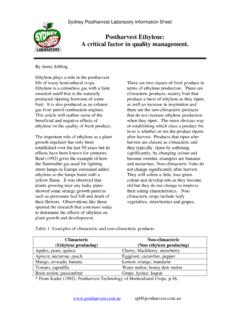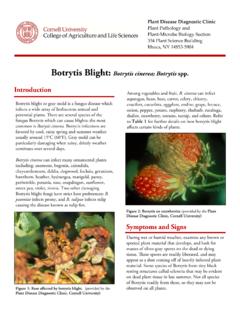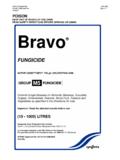Transcription of Essential Oils: A new idea for postharvest disease control.
1 Sydney postharvest Laboratory Information Oils: A new idea forpostharvest disease Jenny JoblingThere is increasing public concern over thelevel of pesticide residues in food. Thisconcern has encouraged researchers to look forother solutions to synthetic there has been considerable interestin GRAS (generally regarded as safe)compounds. Naturally occurring biologicallyactive compounds from plants are an examplesof GRAS compounds. These plant extracts aregenerally assumed to be more acceptable andless hazardous than synthetic compounds. This means that Essential oils that areregistered food grade materials, could be usedas alternative anti-fungal and anti-bacterialtreatments for fresh produce. The potential forthese types of plant extracts is considerable.
2 Itis a resource that has not been fully Szczerbanik from the University ofWestern Sydney, Hawkesbury and RobynMcConchie from the University of Sydney arecurrently working with Sydney PostharvestLaboratory looking at the use of Essential oilsfor the control of postharvest pathogens. Essential oils are made up of many differentvolatile compounds and the make up of the oilquite often varies between species. It seemsthat the anti-fungal and anti-microbial effectsare the result of many compounds actingsynergistically. These means that theindividual components by themselves are notas a lot of preliminary work has been doneto demonstrate the potential of Essential oilsfor use against postharvest pathogens. Onegroup of researchers tested the antifungalactivity of a range of Essential oils againstBotrytis cinerea.
3 Botrytis is the mainpostharvest pathogen of fresh grapes. Theirwork showed that Essential oils from redthyme (Thymus zygis), clove buds (Eugeniacaryophyllata) and cinnamon leaf(Cinnamomum zeylanicum) prevented thegrowth of Botrytis cinerea. Other researchershave shown that the Essential oil of Monardacitrodora and Melaleuca alternifolia alsoexhibit antifungal activity against a wide rangeof common postharvest have looked at the effect of tea tree oil as avapour on the growth of Botrytis from grapes(Table 1). Tea tree oil has antibacterial andantifungal properties that have secured it aplace in the commercial pharmaceuticalmarket. We wanted to determine if theseproperties may also be useful for thepostharvest control of fungi on grapes.
4 Ourwork showed that concentrations of between100 and 500 ppm were able to prevent thegrowth of this fungi when it was grown in 1: The effect of Tea Tree oil on thegrowth of Botrytis of oil(ppm)Percentage reduction in colony size(%)0055504010080500100 Sydney postharvest Laboratory Information effect of different concentrations of Tea treeOil on Botrytis can also cause postharvest rots,particularly in vegetables. Most work on anti-bacterial compounds has been on themedicinal application rather than for use onfruit and vegetables. However recent work hasshown that cedar, eucalyptus, thyme andcamomile oils were antagonistic against thefood spoilage pathogens Bacillus cereus,Clostridium botulinum and Listeriamonocytongenes. More work needs to be doneto see if these oils can also stop the growth ofbacteria that cause postharvest oils are not as broad spectrum assynthetic pesticides, but their effectiveness canbe improved by using them in conjunctionwith carefully designed packaging.
5 Thepresence of free moisture in a packageprovides the ideal environment for the growthof many postharvest pathogens. Ourpreliminary research showed that mushroomsexposed to eucalyptus oil and packaged in apaper bag inside a plastic bag had a betteroverall appearance than those mushrooms notexposed to Essential oils. The mushrooms stayed whiter and their weight loss wasreduced. The total bacterial count on thesurface of the mushrooms also showed that theeucalyptus oil vapour had reduced the growthof the bacteria that caused the browning of the research to date has been donetesting the growth of fungi in the laboratoryunder ideal conditions. The difficulty may beto apply the oils effectively under commercialconditions. Essential oils are often fungistaticrather than fungicidal.
6 This means that theystop the growth of the fungi while it is exposedto the oil, but once the oil is removed the fungican continue to grow. Sydney PostharvestLaboratory is currently trying to develop amethod for applying the oils as a vapour at alow concentration during storage of freshproduce. Application of the oil as a vapour at acontinuous, low concentration should preventtainting of the product. Thin skinned products,not surprisingly are more prone to taintingthan those with thicker skins. This work highlights the potential for usingessential oils for postharvest disease control offresh fruit and vegetables. Essential oilsSydney postharvest Laboratory Information have been registered as Food Additivesare much easier to register for postharvest usethan new synthetic pesticides.
7 Application ofthese oils via the vapour phase should alsomake their use more cost effective thandipping. We are continuing our work in aneffort to determine the optimum concentrationof oil for maximum control of the pathogenswith acceptable levels of tainting of theproduct. ReferencesBishop, and Reagan, J. (1998). control ofthe storage pathogen Botrytis cinerea on Dutchwhite cabbage (Brassica oleracea var. capitata)by the Essential oil of Melaleuca of Essential Oil Research 10: 57 - , and Guizzardi, M. (1994).Inhibition of germination and growth of fruitand vegetable postharvest pathogenic fungi byessential oil compounds. Journal of EssentialOil Research 6:173 - , A. and Dubey, (1994).Evaluation of some Essential oils for theirtoxicity against fungi causing deterioration ofstored food commodities.
8 Applied andEnvironmental Microbiology 60(4): 1101 Bhaskara, , Angers, P., Gosselin,A. and Arul, J.(1997). Chara cterization anduse of Essential oil from Thymus vulgarisagainst Botrytis cinerea and Rhizopusstolonifer in strawberry fruits. Phytochemistry47(8): 1515 - , , Solar, , El Ghaouth and , (1997). Rapid evaluation ofplant extracts and Essential oils for antifungalactivity against Botrytis cinerea. PlantDiseases 81(2):204 - article originally appeared in Good Fruitand Vegetables magazine 11(3): 50, August2000 (Melbourne, Australia).Jenny Jobling is research manager at SydneyPostharvest Laboratory. Sydney PostharvestLaboratory provides independent, expertpostharvest horticultural research and laboratory is located at Food ScienceAustralia, North Ryde, NSW postharvest LaboratoryPO Box 52 North Ryde NSW 2113 Ph: 02 9490 8333 Fax: 02 9490 8499 Email.












